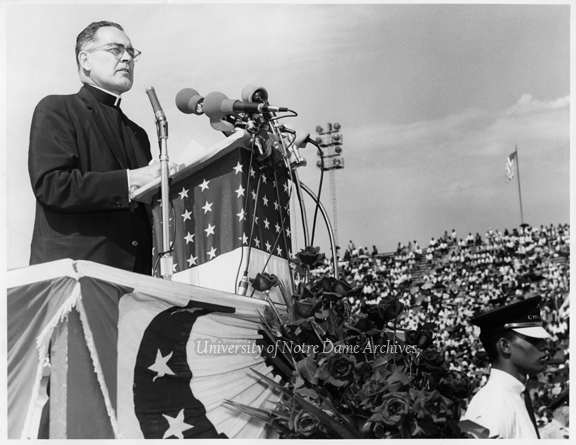
On June 21, 1964, Soldier Field in Chicago played host to the Illinois Rally for Civil Rights. The principle speakers were Rev. Martin Luther King Jr., President and Founder of the Southern Christian Leadership Conference, and Rev. Theodore M. Hesburgh, President of the University of Notre Dame.
The rally, whose operating costs reached $25,000, opened with two hours of jazz and gospel music and entertainment, including a 5000-voice choir led by gospel singer Mahalia Jackson. General admission was free, but priority seating was available for $2-5. Nearly 150 various organizations promoted the event, distributing 1.5 million flyers in Chicago, and brought their members to the rally by the bus-full. A crowd estimated of between 57,000-75,000 people of diverse walks of life, races, and faiths endured early rain and later sweltering heat in Soldier Field, standing in solidarity of racial equality.

The Illinois Rally was somewhat anti-climatic as the passage of the 1964 Civil Rights Bill was imminent – President Lyndon Johnson would sign the bill into law on July 2, 1964. Some were disappointed with the turnout, thinking that it was not as large as it could have or should have been (days before the event, the leaders had estimated the crowd could tip 100,000. The morning rain was blamed for the lower attendance). However, King said to the crowd, “We have come a long, long way in the civil rights struggle, but let me remind you that we have a long, long way to go. Passage of the civil rights bill does not mean that we have reached the promised land in civil rights.” He stressed that the bill alone was not enough – “vigorous enforcement” was essential to success.

Rev. Theodore M. Hesburgh’s involvement in the national Civil Rights Movement dates back to November 7, 1957, when President Dwight Eisenhower named him to the newly formed Civil Rights Commission. Hesburgh, then 40, was the youngest of the six member-commission. Hesburgh would remain on the Civil Rights Commission until 1972.
At the Illinois Rally, Hesburgh echoed King’s sentiments that there was still work to do: “A long road and a hot summer are ahead of us. Every Negro American who does not use his opportunity now is a traitor to his race. Be proud to be a Negro. Demand respect by being worthy of respect. We want to strive for human dignity with you.”
At the time, the Illinois Rally was the second largest Civil Rights demonstration, after the 1963 March on Washington. While there was a small group of protesters outside of Soldier Field, the Illinois Rally was overall a peaceful and successful event.
For more information about the Illinois Rally, please see the following:
Chicago History Museum – Blog post and video about the Illinois Rally. The Chicago History Museum also has WGN newsreel of the Illinois Rally, but it is not available online at this time.
University of Illinois at Chicago Special Collections
Getty Images has more photos of the event online
The National Archives and the UCLA Film & Television Archive have a Hearst Metrotone “News of the Day” newsreel of the Illinois Rally, which is not currently available online.
The Chicago Tribune archives are now available online.
Sources:
PNDP 1964
GPHS 3/
“1964 Civil Rights Act Fast Facts” by CNN

One thought on “Illinois Rally for Civil Rights 1964”
Comments are closed.